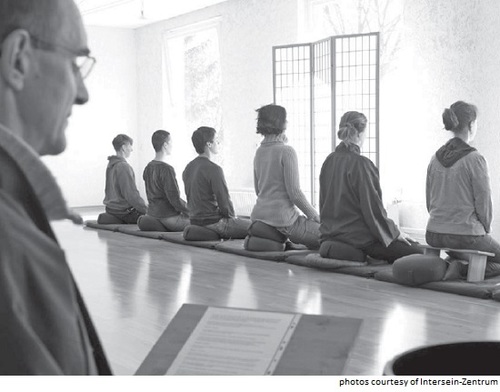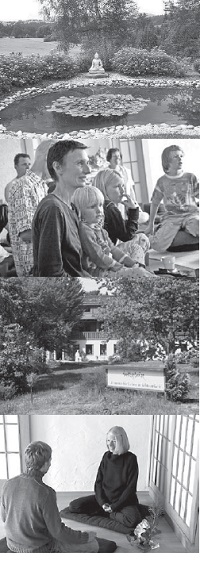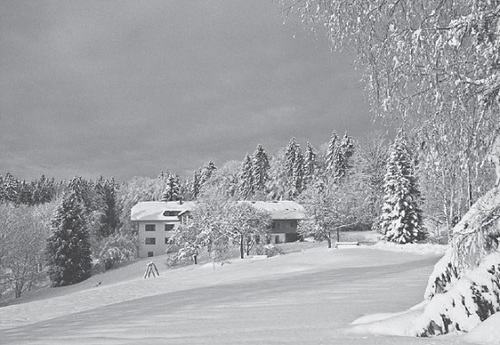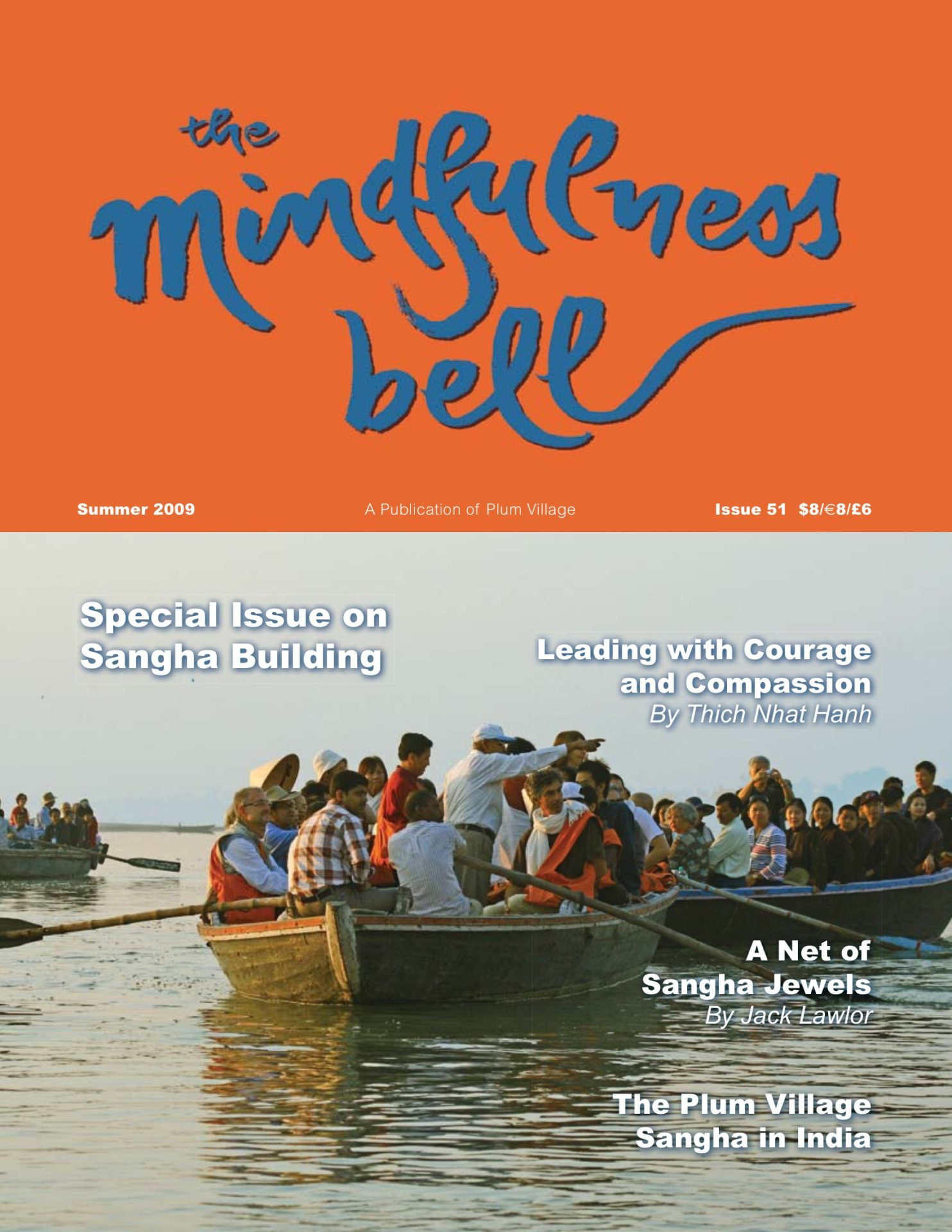Ten Years of Practice in Community
by Karl and Helga Riedl

The Intersein-Zentrum, a practice and meditation center in the lineage of Thich Nhat Hanh, is celebrating its tenth anniversary! This means ten years of concretely and continuously building and maintaining Sangha.
After living in Plum Village for more than six years, we knew very clearly that we were wholeheartedly ready to adopt this practice and this way of life.
Ten Years of Practice in Community
by Karl and Helga Riedl

The Intersein-Zentrum, a practice and meditation center in the lineage of Thich Nhat Hanh, is celebrating its tenth anniversary! This means ten years of concretely and continuously building and maintaining Sangha.
After living in Plum Village for more than six years, we knew very clearly that we were wholeheartedly ready to adopt this practice and this way of life. In May 1999, together with the late Karl Schmied, we founded a residential community in the southeast corner of Germany — the Intersein-Zentrum (Interbeing Center).
Since the very beginning we inspired and attracted people to share our way of life and practice, living under the same roof in the spirit of the Six Harmonies. Over these past ten years, quite a number of people have been inspired by the practice of Thay and happy to share this lifestyle. For some of them, after months or even many years, different priorities emerged and they went on their way — enriched, happier, and with more clarity. Others have stayed with us for as long as nine years. Today we are ten residents sharing our joy and love for the Buddha-Dharma.
The Four Foundations
The first foundation for a Sangha is to be deeply inspired by the Dharma and the practice of Plum Village.
Together with two other friends we moved into a renovated building in early 1999. At the beginning we felt quite lost in that big house, which can host as many as eighty-six people apart from the family retreats, when we host over one hundred people. The four of us began right away with the same schedule that is used in Plum Village: meditation, silent meals, walking meditation, Dharma discussion, etc. One of the principles of our small Sangha from the very beginning has been to never, even in difficult and pressing situations, put the practice aside or skip scheduled activities. There was and still is a lot to do for a small group of people—running a big center and many retreats, being there for guests, implementing fascinating ideas and projects. However, before beginning a new task, we always ask the question: “Is it in accordance with the practice and our schedule?”

The second foundation for a Sangha is that through this emphasis on a constant, uninterrupted practice, gradually the stability and happiness of the small Sangha increases and radiates out.
Living in a residential community, sharing all activities, applying the Six Harmonies, and having only a common income from retreats and guests is a special and demanding practice in itself. The most important practice—and this holds true even for a non-residential Sangha—is to regularly come together and share. To share means to allow everyone to express their joy and their difficulties, inspire others with their insight, and ask for support and understanding. This fosters communication on a very deep level. Furthermore, it is important to be clear about organization, tasks, positions, and the decision-making process, to agree on the structure, and to expose and clarify misunderstandings.
The third foundation for a Sangha is to keep communication alive and open and to make sure the structure is transparent and clear for everybody.
Sharing also means sharing the practice with others—giving and serving. In this way we realize how much we can let go of our self-concern and how well we are rooted in the practice. Once a month we offer a retreat—generally from five days to one week—where we introduce people to mindfulness and different Plum Village practices. Refreshed and with new insight, they return to their families and workplace and when they come back, they report on their experiences: “Just knowing that you are practicing all year round gives us a lot of support and trust.” Most people come back again and again, staying for longer periods to be in close contact with the Dharma and the Sangha. Each summer we offer a retreat for families, which is one of our most important. We stay connected with most of the families for many years, and we can observe with great joy and confidence that they are applying what they have learned and heard.
The fourth foundation for a Sangha is to have a common public activity and responsibility. Within this field we can express the fruit of our practice and we have the opportunity to respond to the actual problems people are facing today.
As a Sangha we are living and practicing in a non-Buddhist environment and it is very important to establish good relationships with our neighbors. Our connection with the nearby villages, which are deeply rooted in Christianity, is friendly, warm, and openhearted. Schoolteachers come here every year with their classes to experience our way of life and even the Catholic priest has visited us several times with his congregation.
The Acceleration of Wisdom
Last year we initiated a winter study and practice training that will run for three years in a row. This arose from seeing the needs and difficulties of practitioners and especially wanting to give those who are deeply motivated the opportunity to enhance and deepen their understanding. Observing the participation and enthusiasm of quite a number of people gives us the confidence that this training corresponds much to the needs of our time. This is another important aspect of a Sangha—to study and deepen the understanding of the Dharma practice and to be able to explain it to others.

We have many Italian friends from Plum Village who come regularly to the retreats we lead in Italy. They have observed over many years the development of the Intersein-Zentrum in Germany. They felt much inspired by how this lay practice center is organized and how the practice is kept alive, so after several years of preparation they are on the way to manifesting a residential practice center in southern Italy. Those who feel committed to living in a residential community are coming here to be trained and some members of our center will go there and support them at the beginning. It is very important for a Sangha to establish a good relationship with other Sanghas, so we can learn from our cultural diversities and open up to each other.
The emphasis in our tradition is the practice of mindfulness and so it is quite natural that we take care of our bodies and our environment. In our center we serve vegetarian food that is based on the principles of Ayurveda and the Chinese five elements; we get protein from a rich variety of beans and nuts. We offer classes in yoga and chi gong. Furthermore we have solar water heating and a very modern wood pellet stove for heat, a large composting pile that we have turned into a beautiful vegetable and flower garden, and a biological sewage system. We are very concerned about driving and we have more than one car-free day. All these different activities are expressions of our practice and they are seen by our guests as examples that they can take home and apply directly in their daily lives.
When we look back over these years, we see that all the difficulties we have faced were indeed “wisdom accelerators,” as Thay calls them. We gained much understanding of the difficulties faced by people who are practicing the Buddha-Dharma in the West, a culture that is deeply materialistic. We continue to learn a lot and to experience more than ever a deep trust in the Three Jewels — while using our modern tools and language that people in the twenty-first century can understand and apply.
Helga Riedl, True Wonderful Loving Kindness, and Karl Riedl, True Communion, were ordained as Dharma teachers by Thich Nhat Hanh in 1994. Their spiritual path began in Poona, India, with Baghwan Sri Rajneesh in 1980 and in 1985 they started Buddhist practice in the Zen tradition. They also studied the Theravada tradition in monasteries in Sri Lanka and Thailand and the Tibetan Gelug tradition at the Lama Tsong Khapa Institute in Pomaia, Italy. It was there they met Thay in 1992 and shortly after followed him to Plum Village.

